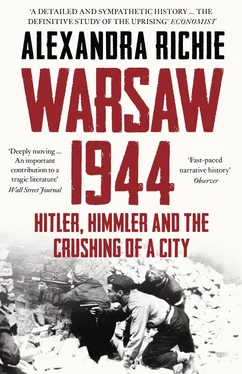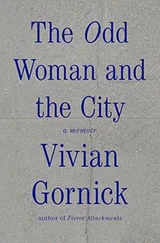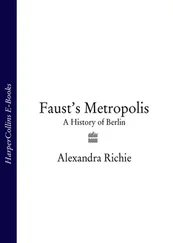But the problem did not go away, and by evening the Germans were starting to get worried. As time went on it became clear that these were not isolated incidents, but that the Poles had managed to stage a simultaneous, well-coordinated attack throughout the whole of Warsaw. By evening the ‘unbeatable’ Stahel was trapped in the Brühl Palace along with his staff, and could do nothing. ‘Himmler wants answers!’ SS Obergruppenführer Wilhelm Koppe, SS and police leader in Kraków, yelled at Brigadeführer Paul Otto Geibel in Warsaw. Geibel was cowering in the basement of his headquarters, which was also under fire, and his troops were pinned down. As news poured in about entire districts being overrun by Polish ‘bandits’, Himmler raced to see Hitler in Rastenburg. He found the Führer purple with rage.
Hitler had good reason to be angry. He had wanted Model’s counter-offensive to be the great set piece of the summer of 1944: ‘If the Eastern Front is stabilized,’ he had told General Walter Warlimont the night before, ‘it would show the Romanians, the Bulgarians, the Hungarians and also the Turks’ that Germany was strong. The last thing he wanted was some ‘ Schweinerei ’ in Warsaw, which would make him look weak, and possibly even give other insurgents an excuse to start their own uprisings.
By this point in the war Hitler was quite deranged. He was more bothered by the injuries he had recently sustained in the 20 July assassination attempt than was commonly known, and was addicted to a cocktail of drugs, including cocaine, administered by his trusted doctor Theodor Morell. He had by now completely lost faith in his generals, whom he blamed for all past failures on the Eastern Front. He was in no mood for leniency. Himmler’s first act upon hearing of the seriousness of the Warsaw Uprising was to send word to Berlin to have the captured Polish resistance leader General Stefan ‘Grot’ Rowecki murdered. Then he tried to calm Hitler down. This uprising was a blessing in disguise, he said. It would give them the excuse to do what they had wanted to do for years – to erase Warsaw from the map.
‘ Mein Führer ,’ Himmler said, ‘the timing is unfortunate. But from a historical point of view it is a blessing that the Poles are doing this. We will get through the four or five weeks [it will take] and then Warsaw, the capital city, the brain, the intelligence of this sixteen-to-seventeen-million-strong Polish nation will have been obliterated. This nation, which has blocked our path to the east for seven hundred years and since the first battle of Tannenberg, has always been in the way. Then the historic problem will no longer be a major one for our children, for all those who come after us, or for us either.’ Hitler, ever the opportunist, agreed. He and Himmler drafted the Order for Warsaw that evening. It stands as one of the most chilling documents of the war.
Warsaw was to be razed to the ground – ‘ Glattraziert ’ – so as to provide a terrifying example for the rest of Europe. Himmler passed the order on to General Heinz Reinefarth personally. It read: ‘1. Captured insurgents ought to be killed regardless of whether they are fighting in accordance with the Hague Convention or not. 2. The part of the population not fighting, women and children, should likewise be killed. 3. The whole town must be levelled to the ground, i.e. houses, streets, offices – everything that is in the town.’
In one evening Himmler and Hitler had decided that the entire population remaining in one of Europe’s great capital cities was to be murdered in cold blood. Then the city – which Himmler referred to as ‘that great abscess’ – was to be completely destroyed. Hitler had often talked before about the utter destruction of cities – Moscow, Leningrad, Minsk – but this was the first and only time he was actually able to put his insane ideas into practice. Tragically, this order was largely fulfilled. That is the story of this book.
Before the ravages of the Second World War, Warsaw was one of Europe’s great capital cities. It had grown quickly in its seven-hundred-year history, reaching dizzying heights during the late-sixteenth- and early-seventeenth-century Polish-Lithuanian Commonwealth. In the nineteenth century its star had waned as it languished under hated Russian rule, but all that changed in 1918.
11 November might be a day of sombre commemoration in much of the world, but not in Poland: for the end of the First World War marked the rebirth of the Polish nation. The generation that came of age there in the 1920s and 1930s loved their capital and their country, and relished their newfound freedom. Warsaw had very serious social, economic and political problems to be sure. But despite this the city flourished once again.
The interwar Poles became known as the ‘Columbus Generation’, always on the lookout for something new and different. Warsaw was their spiritual home. The city had its political, economic and social problems, to be sure, but everything from theatre to newspapers, from cabaret to painting, took off. All government and military institutions had to be recreated from scratch, and new national institutions were founded by the dozen. Despite competition from Kraków and Lwów, Warsaw was fast becoming the political, financial, cultural and intellectual centre of the Polish nation, and acted as a magnet for the most ambitious and creative people in the land. New social housing projects were built by innovative architects; hospitals, schools – indeed entire new districts like Żoliborz – were built for journalists, generals and civil servants. The university was a celebrated centre of learning, and its chemistry and mathematics faculties – under Wacław Sierpiński, who in turn was influenced by the great school in Lwów – led the world. Music, painting and experimental theatre were everywhere. Warsawians watched the first of Pola Negri’s films, read Isaac Bashevis Singer’s subtle depictions of Jewish life in the city, listened to new music by the likes of Karol Szymanowski and read the poetry of ‘Young Picadors’ including Jan Lechoń and Julian Tuwim. After 1933 Warsaw became temporary home to many refugees fleeing Hitler’s Germany; for a brief time they added immeasurably to the life of the city.
This optimistic and vibrant world ended on 1 September 1939. Warsawians awoke that morning to the sound of bombs being dropped on their city. The world had never seen anything like it. It was as if Guernica, in which 1,650 people were killed, was a terrible rehearsal for Warsaw, which was pounded over the course of twenty-seven days in the first air terror attack of the war. On 25 September alone Major General Wolfram von Richthofen’s bombers dropped five hundred tonnes of high explosives and seventy-two tonnes of incendiaries in 1,150 sorties. When the city capitulated on 27 September 25,000 people lay dead in the ruins. Hitler had made it clear – he wanted Warsaw destroyed.
The destruction of the Polish capital was more than mere metaphor; on the contrary, actual plans had been drawn up for the purpose. The ‘Pabst Plan’ of 1939, which Hitler approved just before his invasion of Poland, called for the removal of all but 80,000 of Warsaw’s 1.3 million inhabitants; those who remained would be allowed to live only in the east-bank suburb of Praga. One hundred and thirty thousand Aryan Germans were to be brought from the Reich to live in the new, ideal German town which was to be built in place of the old Polish capital. The ideological justification for the erasure of Warsaw was simple. Warsaw had ‘at one time been German’, but had been ‘corrupted’ by the Poles and the Jews. In a 1942 edition of Das Vorfeld (‘The Approach’ – a periodical for Germans living in occupied Poland), the Nazi historian Dr Hans Hof wrote: ‘In 1420, 85 per cent of the names of burghers in Warsaw were German, and they were the only ones who brought any cultural and economic life, administration and justice to the city.’ ‘Polish immigrants’ changed the city for the worse, ‘as they did in other such places founded by the Germans’. 1The Germans had decided that only the Old Town was worth saving, along with a few palaces that might be used by Hans Frank and Hitler as official residences. The rest of the city was slated for destruction long before the Warsaw Uprising of 1944 broke out.
Читать дальше





![Traudl Junge - Hitler's Last Secretary - A Firsthand Account of Life with Hitler [aka Until the Final Hour]](/books/416681/traudl-junge-hitler-s-last-secretary-a-firsthand-thumb.webp)






